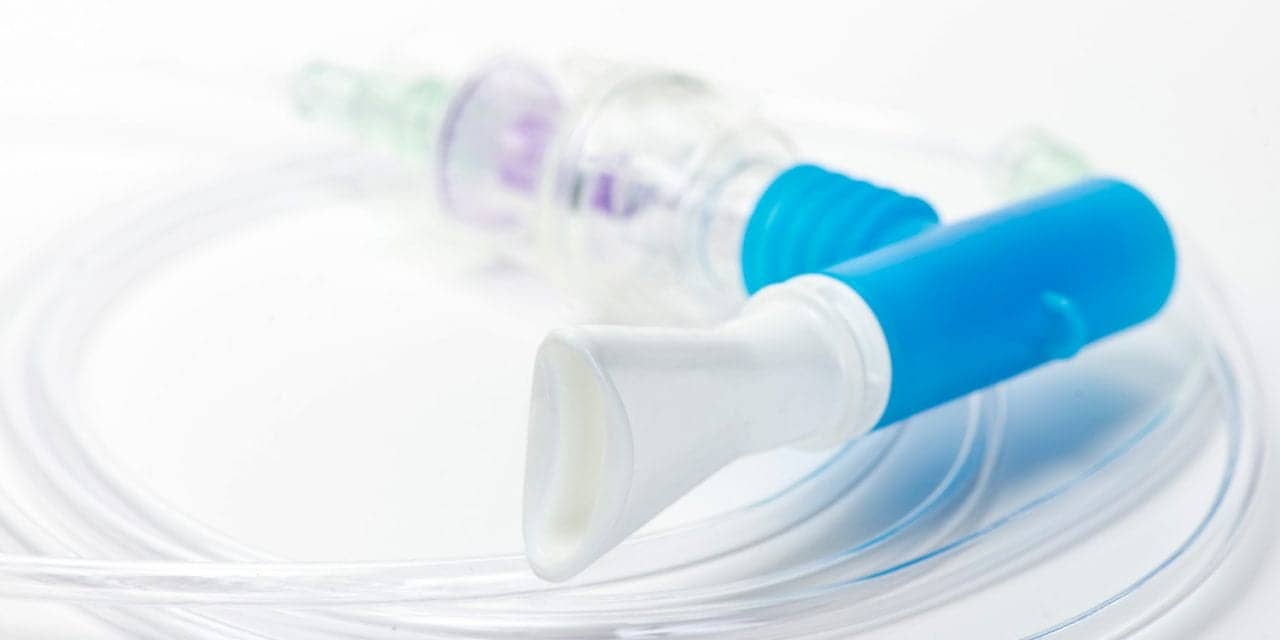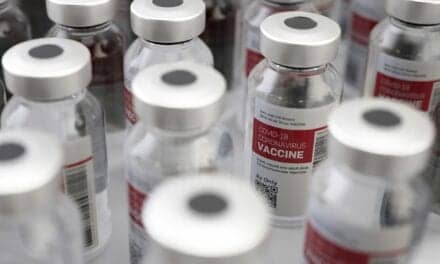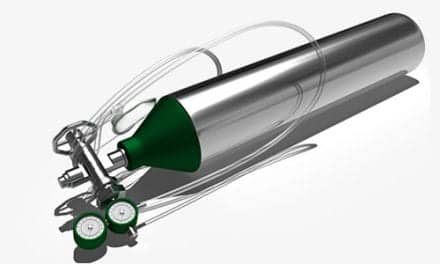Several new SARS-CoV-2 vaccines that target the respiratory system are in development, including one that uses a vibrating mesh to nebulize drops of vaccine doses. Could these new products open the flood gates for the widespread use of inhaled and intranasal vaccines in the future?
BY LISA SPEAR
The COVID-19 vaccines that we have now are effective at preventing hospitalization and death, but they don’t always stop symptomatic infection. As a result, the virus is still spreading through vaccinated people, who are serving as incubators for quick-moving variants. To combat the spread, scientists from across the world are now investigating aerosol and intranasal vaccines to get ahead of emerging variants. Vaccines that are taken up directly into the respiratory system—whether they are inhaled via a nebulizer or sprayed into the nose—mimic the initial moments of natural infection with an airborne pathogen. These vaccines train the immune system to neutralize the virus on contact with the mucus membranes.
“The epithelial lining as well as the lung tissue always keep a lot of different immune cells because we are constantly exposed to a lot of different aerosols,” said Stanford Medicine researcher Ramasamy Paulmurugan, PhD, who is working on developing a nasal spray vaccine. “Because we are not filtering the air during respiration, we are getting exposed to a lot of dust particles, a lot of different infectious agents, so when they go in, they get immediately cleared out from the system. We have a lot of immune cells in the respiratory system.”
Intranasal vaccines are nothing new. FluMist was developed for influenza and researchers have explored nasal vaccines for tuberculosis—but nasal vaccine development has historically taken a backseat to intramuscular vaccines.1 The pandemic fueled new interest in this technology and there are now several clinical trials that are looking at different types of intranasal vaccines, including ones for respiratory syncytial virus and influenza.
“The intranasal vaccine discussions came up again when COVID hit us because it is such a contagious disease,” said Mayuresh Abhyankar, PhD, associate professor of infectious diseases and international health at the University of Virginia.
“Protecting the host, the person who is getting the virus is the first priority, but I think it is equally as important to stop the chain of transmission.”
Several vaccine delivery methods target the respiratory tract, including aerosols that are inhaled, nasal sprays that deliver large particles into the nose through a syringe-like applicator, or even drops that are taken through the nostrils. Once the vaccine hits the mucus membrane, the immune cells which are present directly beneath the mucus membrane take up the vaccine and start mounting protective responses. One example is immunoglobulin A (IgA), an antibody in the mucus.
“These IgA antibodies can literally trap the virus the moment it sticks to our mucus surface. By neutralizing the virus right at the point of entry, they are not only protecting us from getting infected or developing symptoms, but they are also neutralizing the virus, and thus stopping the transmission,” said Abhyankar.
At the University of Virginia, Abhyankar and his colleagues are studying how to use nasal vaccines to prevent diarrheal diseases caused by protozoan parasites, one of the leading causes of mortality in the developing world. “I don’t see any reason why intranasal vaccines won’t become popular in the future,” said Abhyankar.
Respiratory infections, in particular, are promising targets for nasal and aerosol vaccines. At Johns Hopkins Bloomberg School of Public Health and Duke University Medical Center, researchers are evaluating a single dose nasal drop vaccine for respiratory syncytial virus, a common respiratory illness in infants and children around the world. Previous research, published in the American Journal of Respiratory and Critical Care Medicine, found that an intranasal subunit vaccine that introduces the respiratory syncytial virus is effective at generating a lasting immune response in humans.2
On the opposite coast, scientists at Stanford Medicine have developed a COVID-19 nasal spray vaccine that uses gold nanoparticles as a delivery mechanism for their nucleic acid vaccine.3 They are now also working on a study to compare their nucleic acid coronavirus spray vaccine with a mRNA nasal spray vaccine. “We are doing animal studies to see which one is more potent,” said Stanford researcher Paulmurugan.
As we have witnessed with the rapid mass production of the Pfizer and Moderna vaccines, mRNA is easier to mass produce, but it is less stable than nucleic acid vaccines. mRNA vaccines can also be more rapidly cleared from the body. Paulmurugan said, “I think you can trust that the DNA vaccine can be more potent than mRNA.”
Several pharmaceutical companies are waiting to see which nasal spray vaccine is more potent before the technology is launched into clinical trials. The goal, ultimately, is to have patients self-administer nasal spray doses without the help of medical workers. In Colorado, another team of scientists is working on an influenza-COVID nasal vaccine. The company, Vivaldi Biosciences, has already completed four clinical trials to prove the safety and efficacy of their combination vaccine, which could be ready in as little as three years from now, said William Wick, MBA, who is the managing director and CEO.
And the world might also see a nebulized coronavirus vaccine in the coming years. The Chinese pharmaceutical company CanSinoBIO has partnered with Aerogen Ltd to deploy the company’s vibrating mesh aerosol technology to deliver the aerosol, which could reach more people, with fewer resources than intramuscular vaccines, said Jim Fink, Aerogen Pharma chief science officer. “The vibrating mesh is dose sparing allowing you to put a drop of vaccine on the mesh and then make the aerosol,” said Fink. The patient then breathes in the from a disposable cup mouthpiece.
The scientists have detected a good immune response with initial inhalation, said Fink, and the immune response is even greater if given as a booster after an intramuscular vaccine. Inhaled booster vaccines could make life easier for patients who require multiple vaccine doses in short succession, he said.
If proven safe and effective in humans, mucosal COVID vaccines could have many advantages. These aerosol and intranasal vaccines can be easier to administer, particularly to children and other patients who might have a fear of needles, explained Carrie Brown, vice president of marketing and communications for Vivaldi Biosciences. Since no sharps are required, there is less of a chance of contamination, a lower risk of spreading infectious diseases, as well as the elimination of the cost of both procuring the needles and disposing of them. Additionally, intranasal vaccines do not require the same level of training to administer as intramuscular vaccines, which could further cut costs.
“A syringe and a needle, every time you need to get a jab, is pretty expensive. If you have a mesh that could vaccinate 200 or 400 people a day and you could dispose of that mesh, it is a fraction of the cost,” said Fink. “It is also much easier to dispose of without having sharps in disposal fields if they don’t properly incinerate needles and syringes. When you are in an environment where they don’t have the proper systems for incinerating the needles, they end up in trash heaps, kids play in them, they could get jabbed, and they could get hepatitis. With an aerosol, at the end of the day disposal mass is much lower and you have a mesh and it does not come with that risk.”
By using disposable cups with the nebulizer mesh system, said Fink, an aerosol vaccine can treat more people in less time than an intramuscular jab. If clinical trials continue to go well, we could be seeing aerosolized COVID-19 vaccines enter the market within the next few years. “This is an exciting period,” Fink said.
While the benefits of intranasal vaccines are clear, Abhyankar said, so are the potential pitfalls. Since the vaccine is administered close to the brain, rigorous studies will have to be undertaken.
“Safety is going to be the most important issue for nasal vaccines just because of the proximity of the nasal canal to the brain. Plus, we have an opening for olfactory nerves in our nasal canal, so we have to be absolutely sure that if we are using some sort of additives or adjuvant systems as a part of the vaccine, then a rigorous safety evaluation is a must,” said Abhyankar.
Also, “When you take an intramuscular vaccine—it is in the body—there is no way it is going to get out. But with intranasal, our bodies are constantly having secretions to keep out allergens, dust, any foreign particles, it sometimes can be difficult to make sure that the complete vaccine dose has been administered,” said Abhyankar. As time goes by, scientists have developed ways to deal with this and we now have advanced adjuvants that ensure the delivery of the vaccine to the immune cells.
Overall, the future looks promising for vaccines that enter the body through the respiratory system. According to Paulmurugan, nasal and aerosol vaccines could one day dominate the market. “That is our expectation,” he said.
RT
Lisa Spear is associate editor of RT magazine. For more information, contact [email protected].
References
- Kumar S, Bhaskar A, Patnaik G, Sharma C, Singh DK, Kaushik SR, Chaturvedi S, Das G, Dwivedi VP. Intranasal immunization with peptide-based immunogenic complex enhances BCG vaccine efficacy in a murine model of tuberculosis. JCI Insight. 2021 Feb 22;6(4):e145228.
- Ascough S, Vlachantoni I, Kalyan M, et al. Local and systemic immunity against RSV induced by a novel intranasal vaccine: a randomised, double-blind, placebo-controlled trial. Am J Respir Crit Care Med.
- Kumar U, Afjei R, et al. Gold-nanostar-chitosan-mediated delivery of SARS-CoV-2 DNA vaccine for respiratory mucosal immunization: development and proof-of-principle
ACS Nano. 2021 15 (11), 17582-17601.










